Abstract
The typical and most widespread stress concentrators in the lower wing panels of aircraft are the drain holes located on the stringer vertical ribs. These are prime sources for the initiation and development of fatigue cracks, which lead to early failure of the wing structure. Therefore, improving fatigue life in these critical areas is one of the significant issues for research. Two combined methods of surface plastic treatment in the location around drain holes are discussed in this paper. Using the finite element method and ANSYS software, we created a finite element model and obtained nonlinear solution results in the case of tension in a plate with three holes. In addition, the development of residual stress due to the surface plastic treatment of the hole-adjacent areas was taken into account. In this paper, it is shown that after surface treatment of the corresponding areas of the holes, residual stress, which exceeds the yield stress for the plate material, is induced. When combined with alternative tensile stress, these reduce the amplitude of the local stresses, thus increasing the number of stress cycles before failure. The benefits of this technology were confirmed by fatigue test results, which include the fatigue failure types of the plates. Graphs showing the impact of applicable surface treatment combined methods on the number of cycles to failure were also plotted.
1. Introduction
Aircraft structural components experience cyclic loading during operation that causes damage accumulation, fatigue crack initiation and development, and eventually failure. Stress and strain concentration in these components is the major factor which defines the strength and fatigue life of the structural elements. The typical and most widespread stress concentrators in wing structural components are holes. All holes made in structural elements can be conventionally divided into two classes: free unused holes and fastener holes, which are either free of loads or carrying loads. The former class are drain holes, which are going to be considered in this paper.
To ensure the reliability and the assigned service life of wing panels in the area of drain holes, the stress and strain concentration must be reduced. Consequently, a current challenge in designing new structures or modifying existing ones is in developing and applying design and technological methods for improving structural elements’ fatigue life in stress concentration areas.
Surface plastic deformation (SPD) methods have proved to be effective in enhancing the fatigue life of wing panels around drain holes, as demonstrated by the results of fatigue tests [1,2,3,4,5]. The primary concept underlying these methods is to create residual compressive stresses near the stress concentrator. These stresses, when combined with cyclic tensile stress, reduce the amplitude of local alternating stresses, thereby increasing the number of stress cycles before failure. Additionally, these surface treatment methods have the positive effect of smoothing microroughness and waviness on the surface, thereby enhancing surface roughness and accuracy.
A brief description of the publications focusing on the enhancement of fatigue life in structural components within areas of stress concentration, along with the significant results, is provided below.
Sasan Faghih et al. [6] conducted a series of fatigue tests to find the optimal degree of expansion that resulted in the greatest enhancement in fatigue performance of cold expanded samples. The study revealed that a 6% cold expansion was the optimum expansion level for the investigated material, resulting in substantial plastic deformation around the hole without causing any macro- or micro-structural damage under the processing conditions. A digital image correlation (DIC) technique was adopted for crack detection and monitoring to examine the effect of the cold expansion process on crack growth behavior. It was found that cold expansion not only postponed the crack initiation but also considerably decreased the crack growth rate in cold-expanded specimens.
Qi Li, Qichao Xue et al. [7] performed a three-dimensional finite element analysis of cold expansion strengthening of the 7050 aluminum alloy orifice plate to study the distribution of von Mises and residual stress around the hole after cold expansion. The influence of different parameters such as extrusion amounts and plate thickness on the residual stress distribution around the hole was analyzed. The relationship between extrusion amount, plate thickness, and residual stress was obtained. An X-ray diffraction (XRD) technique was employed to measure the residual stress on the surface of the extrusion entrance and to validate the finite element modeling results. The study results indicated that the cold expansion process of slotted bushing holes can enhance the residual stress distribution around the hole and form a strong residual stress layer. As the amounts of extrusion increased, the residual stress tended to increase, reaching the maximum when the amounts of extrusion were 4%.
Wuzhu Yan et al. [8] proposed a bi-directional cold expansion procedure to study the homogenization of residual stress in the thickness direction of the cold-expanded hole, which enabled further improvement of the antifatigue performance of the cold-expanded hole. To investigate the effectiveness of the bi-directional cold expansion procedure and find the optimal process parameters, a series of finite element (FE) simulations were carried out. The results showed that the optimized bi-directional cold expansion process generated a more uniform distribution of residual circumferential compressive stress in the thickness direction compared to the simplified bi-directional cold expansion process using a single mandrel.
The authors of the work [9] applied finite element modeling and fatigue testing to compare residual hoop stresses induced by the cold expansion process using multiple balls with those arising from the cold expansion using a single ball and a tapered mandrel. The results showed that the use of three incremental balls significantly reduced the magnitude of non-conforming residual hoop stresses and the extension of this detrimental zone.
Ambriz R. et al. [10] evaluated the influence of variable load spectra on the fatigue crack growth of cold-expanded specimens. The results of the fatigue tests showed a 3.5 times improvement in the fatigue life of cold-expanded holes compared to untreated holes.
Zuccarello B. and Franco G Di. proposed a numerical experimental method for the analysis of residual stresses in cold-expanded holes [11]. The idea of the proposed method was to determine the residual strains through the thickness of the specimen near the hole in circumferential direction at different values of interference fit. In this case, rectangular grooves were successively milled on both sides of the plate. Strain gages attached to both sides of the plate were used to measure residual strains. The measured values of residual strains were used to calculate the residual stresses through the thickness of the specimen near the hole using the integral method, which involved computation of the influence matrix. In order to calculate influence coefficients, a numerical simulation was carried out using the boundary elements method and the commercial code BEASY 9.0.
Karuppanan S., Hashim M. H., and Wahab A. A. presented the results of a numerical study of the influence of the proximity of hole location and plate thickness on the distribution of residual stresses in a plate with two holes made of 7075-T6 aluminum alloy in the case of cold expansion of the hole [12]. Two-dimensional and three-dimensional models were created in ANSYS to obtain the results. It was shown that as the distance between adjacent holes increased, the residual stresses decreased. As the thickness of the plate increased, stresses decreased. Moreover, the residual stresses at the mid-thickness of the plate were higher than the results at the entrance and exit faces.
V. Archard et al. [13] assessed the influence of the cold expansion ratios on the fatigue strength of Ti-6Al-4V tensile specimens by conducting an experimental and numerical study. The aim of the study was to understand the impact of the high-expansion ratio in titanium holes and the influence on fatigue performance. The authors argued that a very good correlation between the experimental and numerical results was observed.
Gao Y. and Zhong Z. pointed out that residual stresses have a significant effect on material fatigue, stress corrosion cracking, and other fracture parameters [14]. The authors presented a set of parameters describing the residual stresses in the specimen for different types of treatment such as shot peening, hole cold expansion, laser shock peening, and ultrasonic peening. A series of experiments was used to study the effect of residual stresses on the initiation and propagation of fatigue cracks in specimens of aluminum alloys, steel, and titanium.
Yang Z., Lee Y., He S., Jia W., and Zhao J. introduced parameters such as dent size, the distance between shots, and shot numbers for a quantitative description of shot peening coverage [15]. A finite element simulation of shot peening was carried out using the commercial finite element program, ABAQUS, to estimate the surface treatment intensity by comparing results of the finite element simulation with the results of the Almen test.
Zarutskiy A. proposed a method for residual stress accounting, which was produced during barrier compression by introducing the concept of additional dummy compressive stresses [16]. Experimental verification of the proposed method to predict fatigue life was carried out using a series of pre-compressed specimens made of the D16AT (Д16AT) and V95pchT2 (B95пчT2) alloys. The influence of the compression depth, swage width, and sweep angle on variations in residual stress was analyzed.
Calif-Chica J., Marin M. M., Rubio E. M., Teti R., and Segreto T. presented the results of their numerical parametric simulation of the thick-walled cylinder hole cold expansion process obtained for an axisymmetric model using the finite element method and ANSYS v.19 software [17]. The influence of geometric parameters of a mandrel on the value of residual stresses and forces during hole cold expansion was investigated.
Aid A., Semari Z., and Benguediab M. proposed a method for studying the effect of the radial interference value during hole cold expansion on the growth rate of a fatigue crack in a strip of the 6082A T6 aluminum alloy [18]. The method involved carrying out numerical simulations and a full-scale experiment with subsequent verification of the results. The finite element analysis was used to simulate the fatigue crack growth in a plate with a central hole using the ANSYS software. Based on the simulation results, using Irwin’s theory, the stress intensity factor was calculated. The Paris equation was used to estimate the fatigue crack growth rate. The experimental part of this work was subdivided into three steps: a quasi-static tensile test to determine the mechanical characteristics of the material, fatigue tests, and cold expansion with different degrees of expansion. The cold working expansion process was realized by forcing a hard steel ball of 6 mm inside a predrilled hole.
P. Yasniy, O. Dyvdyk et al. [19] adopted an experimental technique to examine the impact of cold expansion holes in D16chT aluminum alloy plates with a pre-existing quarter-elliptical crack on fatigue crack growth and residual life. It was found that cold expansion of the hole with an expansion ratio of 2.7% significantly retarded the fatigue crack growth rate and increased residual lifetime by three times.
Vorobiov Y., Voronko V., and Stepanenko V. presented the results of a comparative analysis of quasi-static low-speed, high-speed, and pulse hole cold expansion processes. For comparison, the authors used a multivariate full-scale test [20]. The test results showed that in the case of impulse hole cold expansion, the hourglass shape of the hole decreased by 4–5% in comparison with quasi-static low-speed hole cold expansion. It was also noted that galling on the supporting surface decreased during impulse hole cold expansion with varying degrees of interference.
Sementsov V. and Vasylevskyi E. analyzed the influence of some of the parameters of technological tools used for barrier compression and the loading level on the characteristics of the local stress–strain state of a plate with a hole during its tension [21]. It was found numerically that the use of barrier compression with a depth of 0.3 mm helped to reduce the maximum principal stresses of an equivalent repeated cycle by 1.5–2.2 times in the section along the axis of hole and by 1.4–1.7 times in the compressed zone, with respect to stresses for a plate with an untreated hole.
The aim of this work is to estimate the possible benefits of using surface treatment-combined methods for enhancing the fatigue life of lower wing panel structural elements in the area of a drain hole by carrying out numerical simulations and fatigue testing.
2. Initial Data
A specimen of a plate with three holes of 8 mm in diameter was used to simulate operation under loading of the real part of the structure which contains drain holes.
A rectangular plate (Figure 1) has the following geometric dimensions: the plate thickness is 5 mm, width in sections along the axes of holes is 48 mm, the hole diameter is 8 mm, ratio of plate width to diameter (B/d) is 6, and the distance between the centers of the holes is 12 mm. The edges of the holes are chamfered with dimensions of 0.5 × 45°.
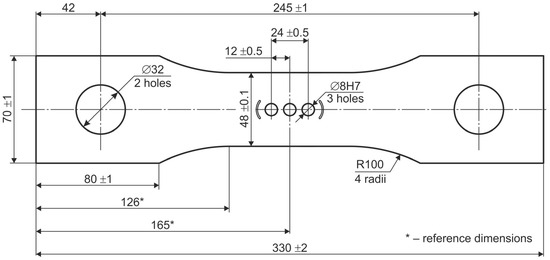
Figure 1.
Specimen of plate with three holes of 8 mm in diameter.
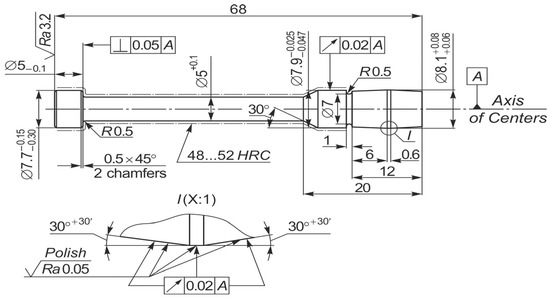
Figure 2.
Geometry and main dimensions of mandrel.
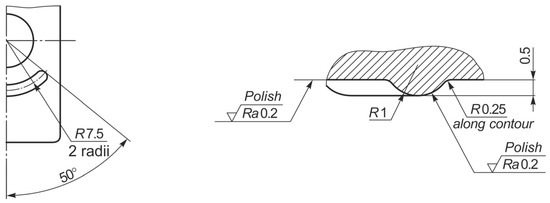
Figure 3.
Geometry and main dimensions of swage for stamping of segment dimples.
The two combined methods of surface plastic treatment in the location around drain holes are:
- holes rolling with an interference of 0.4% and barrier segment compression around the holes with a depth of 0.3 mm;
- hole cold expansion with an interference of 2% and barrier segment compression around the holes with a depth of 0.3 mm.
Figure 2 and Figure 3 show the geometry and main dimensions of the technological tools used for treatment.
The plate material is the D16T (Д16T) aluminum alloy (Figure 1), which has the following physical and mechanical characteristics: Young’s modulus E = 72,000 MPa, Poisson’s ratio ν = 0.3, yield stress σ0.2 = 285 MPa, and ultimate stress σB = 430 MPa [22]. As the local stresses on the plate in the vicinity of the holes exceed the yield stress resulting in developing permanent plastic deformations, nonlinear structural analysis is conducted which requires the definition of the stress–strain curve. Figure 4 shows a true stress–strain diagram of the D16T (Д16T) aluminum alloy.
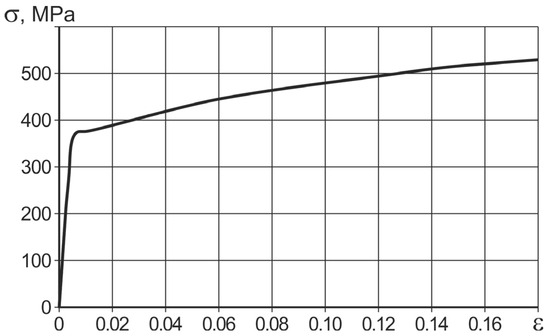
Figure 4.
True stress–strain diagram of specimen from D16T (Д16T) aluminum alloy.
The mandrel (Figure 2) is made of steel KhVG (XBГ) according to GOST 5950-73 [23] with the following characteristics: Young’s modulus E = 200,000 MPa, yield stress σ0.2 = 1400 MPa, ultimate tensile stress is σB = 1600 MPa, and Poisson’s ratio is ν = 0.3 [24].
The swages (Figure 3) used for barrier compression are made of the U8A (У8A) steel according to GOST 1435-90 [25] with the following characteristics: Young’s modulus E = 200,000 MPa, yield stress σ0.2 = 750 MPa, ultimate tensile stress σB = 1200 MPa, and Poisson’s ratio ν = 0.3 [24].
The finite element method and ANSYS software are used to calculate the local stress–strain state in the plate.
To carry out nonlinear structural analysis, the boundary and contact conditions are applied as follows:
- Boundary conditions.
Symmetry condition:
Force boundary condition:
- Contact conditions.
Here, Ux, Uy and Uz are the components of the displacement vector in the global Cartesian coordinate system; , , and are boundaries on which symmetry condition is applied; are stress tensor components; ni is the unit normal vector; and are the coordinates of nodes on target and contact surfaces; g is the gap which defines permissible interpenetrations of nodes; and are surfaces on which contact conditions are applied.
Figure 5 shows the plate with three holes with a visualization of the boundary conditions and applied loads.
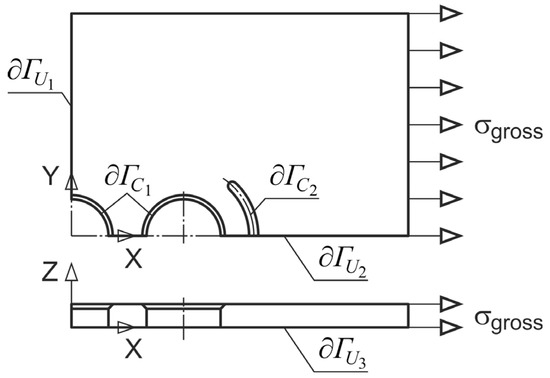
Figure 5.
Plate with three holes with visualization of boundary conditions and applied loads.
3. Finite Element Modeling
Because of the symmetry of the model and applied loads, only 1/8 of the plate is used for the three-dimensional modeling in ANSYS, with appropriate boundary conditions set on the symmetry planes. Due to the fact that the rigidity of the technological tool used for treatment is three times higher than that of the plate, and that in this study stress and strain in the tool are outside the area of interest, we then consider the tool to be a rigid body. This allows us to reduce the overall dimensions of the finite element model and computational costs.
The finite element model of the plate (Figure 6) consists of a set of the three-dimensional elements of the solid deformable body, SOLID45 [26]. The element is defined by eight nodes having three degrees of freedom at each node: translations in the nodal x, y, and z directions.
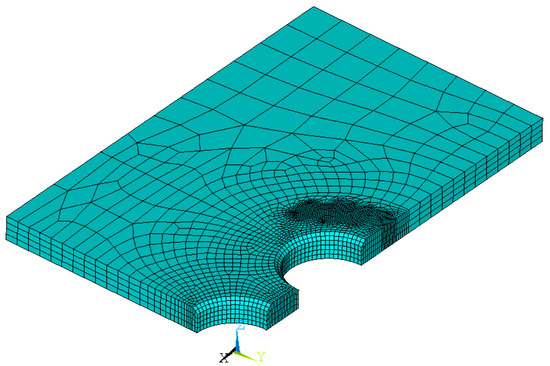
Figure 6.
Finite element model of plate with three holes.
To accurately capture the local stresses in the stress concentration regions, a fine mesh was generated around the holes and in the area of the segment dimples; meanwhile, in the other regions which were far away from the stress risers, the model had a coarse mesh (Figure 6 and Figure 7).
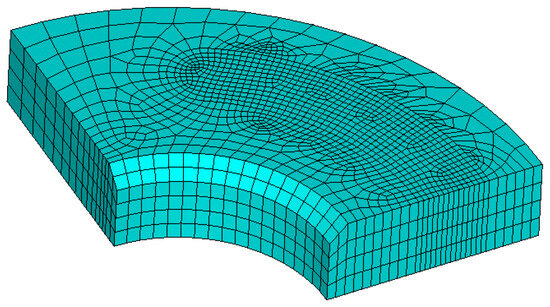
Figure 7.
Portion of finite element model of plate with three holes in the area of segment dimple stamping.
Figure 8, Figure 9 and Figure 10 show the finite element models of the roller, mandrel, and swage which were created with the conditions described in this section.
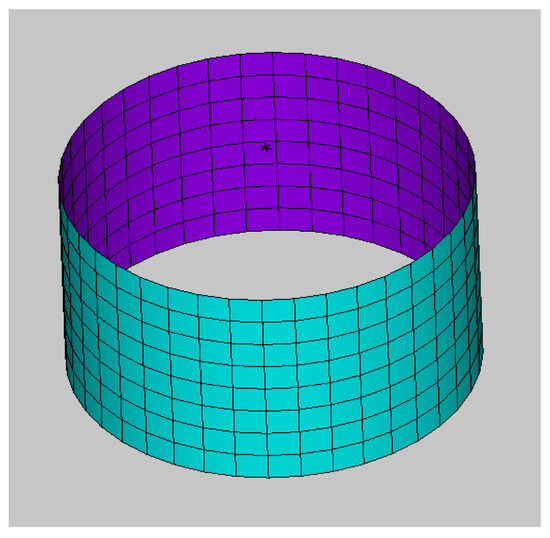
Figure 8.
Finite element model of roller.
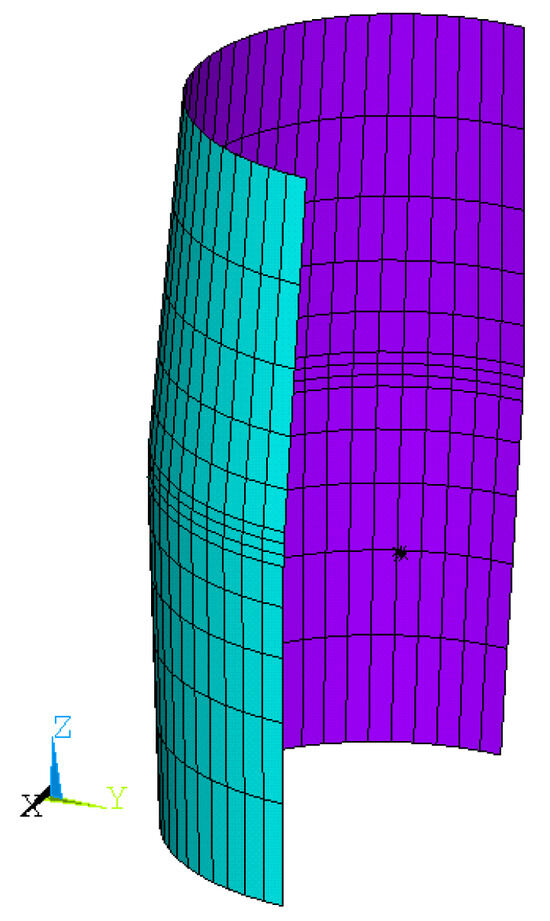
Figure 9.
Finite element model of mandrel.

Figure 10.
Finite element model of the swage for stamping of segment dimples.
Contact Impact Model
A general “Surface-to-Surface” contact model was used to simulate contact interaction between the technological tool and respective areas of the plate [27]. The “Rigid-to-Flexible” type of contact was used for this model [27], where the technological tool is considered to be a rigid body and the plate is considered to be a deformable body.
Contact surfaces are defined via a set of the TARGE170 target elements [26] and the CONTA173 contact elements [26].
The target elements are overlaid on the part that defines the technological tool geometry, while the contact elements are overlaid on the respective surfaces of the plate. To include friction in the contact algorithm, the Coulomb model of friction was used by setting the friction factor as f = 0.6. The pilot node has six degrees of freedom and is used to control six independent motions of the entire target surface of the rigid body: three translations along the X, Y, and Z direction and three rotations around X, Y, and Z. Interference occurring during rolling and hole cold expansion processes was modeled geometrically by considering an oversized roller or mandrel that was pushed through the hole to yield it and to generate residual compressive stress. The initial penetration of the target elements through the contact surface was included in the contact algorithm. The motion of the mandrel and swage was modeled by setting respective translations in pilot nodes in a negative Z direction.
Nonlinear analysis was carried out taking into account geometric and material nonlinearities. In this case, the level of design loads was set equal to four numbers of gross stress σgross = 0, 100, 130, and 150 MPa.
4. Results
The following section presents the numerical simulation and fatigue test results. The main results of the finite element modeling involve von Mises stress distributions at the different stages of the surface treatment and provide graphs showing the impact of loading level and treatment method on the variation in maximum principal stresses, strains, and specific strain energy of the repeated stress cycle in the plate. The fatigue test results are fatigue failure types of the specimens tested and graphs are provided illustrating the number of cycles to failure for the plate specimens with and without surface treatments.
4.1. Numerical Modeling Results
Using the finite element model created in ANSYS software, we carried out a step-by-step simulation of the surface treatment process in the areas surrounding the holes. Then, we followed this with tensile loading of the plate in order to study the effect of application of the considered treatment methods on the fatigue life of the plate with holes. Local stress–strain state parameters were calculated in two areas:
- cross-section along the extreme hole axis;
- stamping area of segment dimples.
The amplitude of the principal stress, strain, and specific strain energy were calculated in the cross-section along the extreme hole axis and the stamping area of segment dimples, using the following equations:
in which:
- σ1max, ε1max, and w1max are the maximum principal tensile stresses, strains, and specific strain energy. We took the value of the local parameter (stress, strain, or specific strain energy) in the corresponding area for the state when external loads are applied as the maximum value.
- σ1min, ε1min, and w1min are the minimum principal tensile stresses, strains, and specific strain energy. We took the value of the specific parameter in the corresponding area for the state corresponding to the load release as the minimum value.
When calculating strain amplitude, elastic strain was considered, because it significantly changes during cyclic loading.
The initial loading cycle (Figure 11) was converted to an equivalent repeated cycle using Oding’s formula:
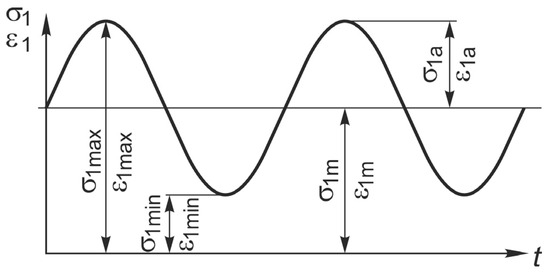
Figure 11.
Loading cycle and its parameters.
The mechanism of the plastic strain area formation was studied and distribution of the von Mises stress in the plate with three holes was analyzed step by step in the case of the treatment using the hole cold expansion method with an interference of 2% and following stamping of the segment dimples (Figure 12). The unit of the von Mises stress is MPa.
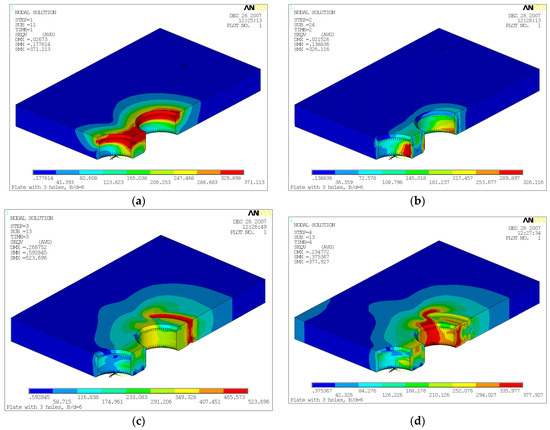
Figure 12.
Distribution of the von Mises stress in a plate with three holes in the case of using the hole cold expansion method with an interference of 2% and following barrier stamping with a depth of 0.3 mm: (a) initial step is penetration of mandrel; (b) after hole cold expansion; (c) after hole cold expansion and following stamping with a depth of 0.3 mm; (d) after surface treatment when the tools are removed.
4.2. Experimental Results
To carry out experimental studies to determine the characteristics of fatigue life, standard specimens were designed as follows: a plate with a central hole (B/d = 6) (Figure 13); a plate with three holes of 8 mm in diameter (distance between hole centers is 12 mm); without treatment (Figure 14); and with surface treatment in the hole areas (Figure 15). The shape and dimensions of the test specimen were designed in accordance with [28].

Figure 13.
Test specimen of plate with central hole.

Figure 14.
Test specimen of plate with three holes.

Figure 15.
Test specimen of plate with three holes treated around holes.
The tests of specimens of plates with holes were carried out in the “STRENGTH” research laboratory of the National Aerospace University’s “Kharkiv Aviation Institute”, using the UMM-02 electromechanical test machine. Specimens of plates were loaded with uniaxial alternating cyclic loads with a frequency of 12 Hz. Specimens of plates were tested at the level of cyclic loading of σgross min = 0 MPa and σgross maz = 150 MPa.
Three specimens of the plates with a central hole were tested at this loading level. The fatigue failure of specimens took place in a section along the axis of the hole. Fatigue cracks were initiated on the edge between the conical surface of chamfer and the cylindrical surface of the hole. Figure 16 shows the regions and fatigue failure types.

Figure 16.
Fatigue failure of specimens of plates with central holes fabricated from pressed section (D16Т (Д16) aluminum alloy) with a loading spectrum of σgross min = 0 MPа and σgross maz = 150 MPa; arrow in figure ( ) is the area where fatigue crack is initiated; 1-1, 1-2, 1-3 are numbers of specimens.
) is the area where fatigue crack is initiated; 1-1, 1-2, 1-3 are numbers of specimens.
 ) is the area where fatigue crack is initiated; 1-1, 1-2, 1-3 are numbers of specimens.
) is the area where fatigue crack is initiated; 1-1, 1-2, 1-3 are numbers of specimens.
Three specimens of plates with three untreated holes were tested. The fatigue failure of specimens occurred in a section along the axis of the extreme hole. Fatigue cracks were initiated on the edge between the conical surface of the chamfer and the cylindrical surface of the hole. Figure 17 shows the areas and fatigue failure types.
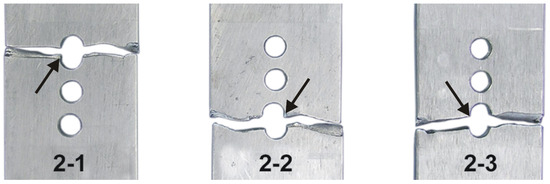
Figure 17.
Fatigue failure of specimens of plates with three untreated holes fabricated from pressed section (D16Т (Д16) aluminum alloy) with a loading spectrum of σgross min = 0 MPа and σgross maz = 150 MPa; arrow in figure ( ) is the area where fatigue crack is initiated; 2-1, 2-2, 2-3 are numbers of specimens.
) is the area where fatigue crack is initiated; 2-1, 2-2, 2-3 are numbers of specimens.
 ) is the area where fatigue crack is initiated; 2-1, 2-2, 2-3 are numbers of specimens.
) is the area where fatigue crack is initiated; 2-1, 2-2, 2-3 are numbers of specimens.
Three specimens of plates with three holes were tested, which were treated using the rolling method with an interference of 0.4% and barrier compression. Crack propagation in specimen No. 3-1 started from the surface in the area of the extreme hole, in specimen No. 3-2 crack propagation started from the surface in the area of the extreme hole and segment dimple, and specimen No. 3-3 failed at the grips location due to fretting corrosion. Figure 18 shows the areas and fatigue failure types of the specimens tested.
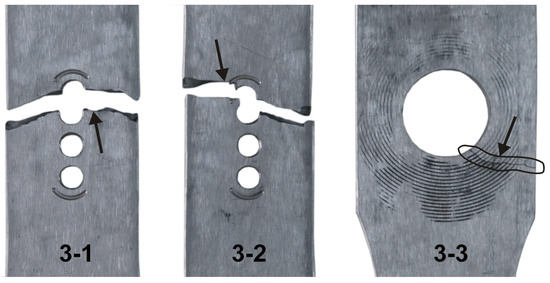
Figure 18.
Fatigue failure of specimens of D16 (Д16) aluminum plates with three holes treated using rolling with an interference of 0.4% and barrier compression with a loading spectrum of σgross min = 0 MPа and σgross maz = 150 MPa; arrow in figure ( ) is the area where fatigue crack is initiated; 3-1, 3-2, 3-3 are numbers of specimens.
) is the area where fatigue crack is initiated; 3-1, 3-2, 3-3 are numbers of specimens.
 ) is the area where fatigue crack is initiated; 3-1, 3-2, 3-3 are numbers of specimens.
) is the area where fatigue crack is initiated; 3-1, 3-2, 3-3 are numbers of specimens.
Three specimens of the plates with three holes were tested, which were treated using the hole cold expansion method with an interference of 2% and barrier compression. Specimen No. 4-1 failed at the grips location due to fretting corrosion. Crack propagation in specimen No. 4-2 started from the surface in the fillet area. Crack propagation in specimen No. 4-3 started from the surface in the section of the extreme hole on the edge between the conical surface of chamfer and the cylindrical surface of the hole. Figure 19 shows the areas and fatigue failure types of the specimens tested.
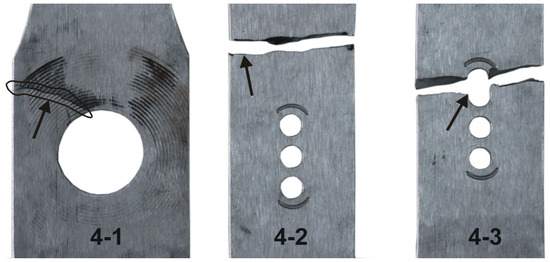
Figure 19.
Fatigue failure of specimens of D16 (Д16) aluminum plates with three holes treated using hole cold expansion with an interference of 2% and barrier compression with a loading spectrum σgross min = 0 MPа and σgross max = 150 MPa; arrow in figure ( ) is the area where fatigue crack is initiated; 4-1, 4-2, 4-3 are numbers of specimens.
) is the area where fatigue crack is initiated; 4-1, 4-2, 4-3 are numbers of specimens.
 ) is the area where fatigue crack is initiated; 4-1, 4-2, 4-3 are numbers of specimens.
) is the area where fatigue crack is initiated; 4-1, 4-2, 4-3 are numbers of specimens.
5. Discussion
In this section, based on the results from the previous sections, the following are discussed: the distribution of principal tensile stress, strain, and specific strain energy of an equivalent repeated stress cycle; the impact of loading level and treatment method on variations in maximum principal stress, strain, and specific strain energy of equivalent repeated cycle in the plate; and the impact of hole number and surface treatment methods on the fatigue life of plates with holes.
The analysis of the stress distribution revealed that in the area to be treated, the local von Mises stress exceeded the yield stress which indicated the development of plastic strain regions in the material during its treatment. The regions are localized in close proximity to the areas of the plate to be treated. In the case of the segment stamping, the plastic strain region is distributed through the entire thickness directly under the dimple formed by treatment. The obtained results indicate that during surface treatment of corresponding areas of the plate, residual compressive stresses are produced which in combination with working tensile stresses lead to a reduction in local stress level in the areas. This, in turn, enhances the fatigue life.
To analyze the impact of loading level and treatment method on variations in maximum principal stress, strain, and specific strain energy of the equivalent repeated cycle in the plate, the graphical dependencies (Figure 20, Figure 21 and Figure 22) between calculated values (see Section 3) of σ01 max and σgross, ε01 max and σgross, and w01 max and σgross were constructed.

Figure 20.
Impact of loading level and treatment method on variations in maximum principal stress of repeated cycles in plate: (a) along the axis of the extreme hole; (b) stamping region.

Figure 21.
Impact of loading level and treatment method on variations in maximum principal strain of repeated cycles in plate: (a) along the axis of the extreme hole; (b) stamping region.
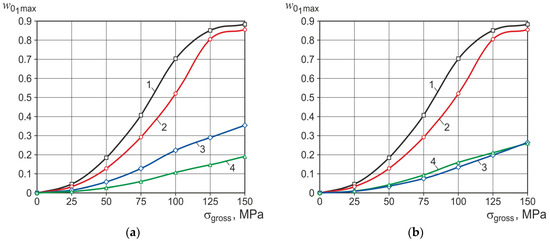
Figure 22.
Impact of loading level and treatment method on variations in maximum principal specific strain energy of repeated cycles in plate: (a) along the axis of the extreme hole; (b) stamping region.
There are four curves on each graphic, which correspond to the following:
- Number 1 represents the plate with a hole of 8 mm in diameter and a chamfer of 0.5 × 45° without surface treatment;
- Number 2 represents the plate with three holes of 8 mm in diameter and a chamfer of 0.5 × 45°; the distance between holes is 12 mm without surface treatment;
- Number 3 represents the plate with three holes of 8 mm in diameter and a chamfer of 0.5 × 45°; the distance between holes is 12 mm in the case of hole cold expansion with an interference of 2% and stamping of segment dimples with a depth of 0.3 mm;
- Number 4 represents the plate with three holes of 8 mm in diameter and a chamfer of 0.5 × 45°; the distance between holes is 12 mm, in the case of rolling with an interference of 0.4% and stamping of segment dimples with a depth of 0.3 mm.
Analysis of the obtained results showed that the stamping region is more dangerous since the characteristics of the local stress–strain state in this region exceed the corresponding characteristics in the area along the axis of the extreme hole.
In the case of combined application of the rolling method with an interference of 0.4% and stamping of segment dimples with a depth of 0.3 mm, the level of the maximum principal tensile stresses of the equivalent repeated cycles in the section along the axis of the extreme hole decreased by 2.16–2.4 times, the maximum principal strains by 2.13–2.33 times, and the specific strain energy by 2.42–3.07 times compared to these characteristics for a plate with three holes without any surface treatment of the holes.
The combined application of hole cold expansion with an interference of 2% and stamping of segment dimples with a depth of 0.3 mm results in decreasing the maximum principal tensile stresses of the equivalent repeated cycles by 1.84–2.06 times, the maximum principal strain by 1.79–2.01 times, and the specific strain energy by 2.51–3.01 times compared to these characteristics for a plate with three holes without surface treatment of holes.
The chart in Figure 23 demonstrates the influence of surface treatment methods on the fatigue life of plates with holes, where the designations (numbers in the rectangles) correspond to the following:
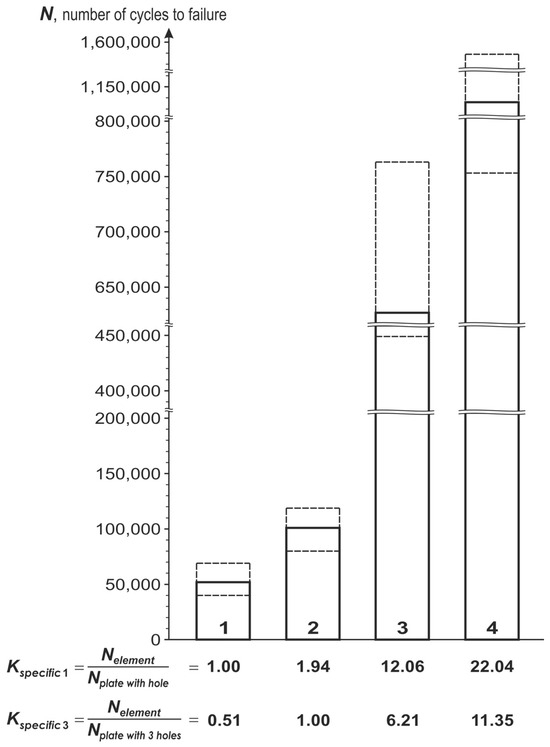
Figure 23.
Impact of hole numbers and surface treatment methods on fatigue life of plates with holes at the loading level of σ0 gross max = 150 MPa.
- Number 1 represents the plate with a central hole of 8 mm in diameter (B/d = 6);
- Number 2 represents the plate with three holes of 8 mm in diameter (B/d = 6) (distance between holes’ center is 12 mm) without surface treatment;
- Number 3 represents the plate with three holes of 8 mm in diameter (B/d = 6) (distance between holes’ center is 12 mm) treated using rolling with an interference of 0.4% and barrier compression;
- Number 4 represents the plate with three holes of 8 mm in diameter (B/d = 6) (distance between holes’ center is 12 mm) treated using hole cold expansion with an interference of 2% and barrier compression.
Figure 23 provides the following notations: Kspecific1 is the ratio of number of cycles of specimens 1, 2, 3, or 4 to the number of cycles of specimen 1 (plate with the hole of 8 mm in diameter); Kspecific2 is the ratio of the number of cycles of specimens 1, 2, 3, or 4 to the number of cycles of specimen 2 (plate with three holes of 8 mm in diameter without surface treatment).
The following results were obtained during fatigue tests: the fatigue life of the plate with three holes treated by rolling with an interference of 0.4% and barrier compression is higher by 12.06 times than the fatigue life of the plate with a central hole. The same enhancement in fatigue life compared to fatigue life of the plate with three untreated holes is by 6.21 times. The fatigue life of the plate with three holes, which are treated by hole cold expansion with an interference of 2% and barrier compression, is higher by 22.04 times than the fatigue life of the plate with a central hole. The same enhancement of fatigue life compared to the fatigue life of the plate with three untreated holes is by 11.35 times.
6. Conclusions
In this paper, the effectiveness of two combined methods of surface plastic treatment to enhance the fatigue life of structural parts with holes is analyzed using numerical simulation and fatigue testing. These combined methods are hole rolling with an interference of 0.4% and barrier segment compression around the holes with a depth of 0.3 mm, and hole cold expansion with an interference of 2% and barrier segment compression with a depth of 0.3 mm.
Initially, we created a finite element model of the plate with three holes of 8 mm in diameter and the corresponding technological tools used for the surface treatment of the hole-adjacent areas to perform a step-by-step simulation of the surface treatment and subsequent tension of the plate. In order to accurately capture the local stresses in the regions of stress concentration, a fine hexahedral mesh was generated there; meanwhile, other regions, which are far from stress rises, have a coarse mesh. Because of the symmetry of the plate and the applied load, only 1/8 of the plate was used for three-dimensional modeling in ANSYS with the application of appropriate boundary conditions on the symmetry planes. Taking into account that the rigidity of the technological tool is three times higher than that of the plate and that in this study, stress and strain in the tool are outside the area of interest, we, therefore, considered the tool to be a rigid body. This enabled us to reduce the overall dimensions of the finite element model and computational costs.
A nonlinear solution of the problem was obtained in ANSYS software with respect to the following nonlinearities: finite deformations, plasticity of the plate material, and contact interaction with friction. Then, distributions of major principal stress, strain, and specific strain energy along the extreme hole axis and stamping area of segment dimples were plotted for two load steps: when the tensile load was applied to obtain the maximum value and after surface treatment of hole-adjacent areas to calculate the minimum value of the local parameters. Based on distributions of the maximum and minimum values of major principal stress, strain, and specific strain energy in these two areas of interest, the amplitude of the local parameters was calculated. After that, the initial loading cycle was converted to an equivalent repeated cycle using Oding’s formula to obtain the maximum values of major principal stress, strain, and specific strains of the equivalent repeated cycle.
Finally, in order to estimate the effectiveness of applicable combined methods of surface plastic treatment, graphs showing variations in the maximum values of major principal stress, strain, and specific strains of equivalent repeated cycles versus operating loading were plotted. The results showed that application of combined surface treatment of the areas in the vicinity of the holes significantly reduced the corresponding values of the maximum major principal stress, strain, and specific strains of the equivalent repeated cycles as compared to these characteristics for a plate with three holes without surface treatment of holes. Consequently, reduction in the corresponding values of stress, strain, and specific energy leads to fatigue life enhancement of the surface-treated specimens.
Concurrently, in order to confirm the numerical simulation results, a series of fatigue tests were carried out. The results of the test comprise fatigue failure of the specimens and a chart showing the impact of the surface treatment methods on fatigue life of plates with holes.
Concerning the fatigue failure of the specimens, the results showed that in the case of using hole cold expansion with an interference of 2% and barrier compression, only one of the three specimens failed in the stress concentration area, whereas all three specimens failed in the stress riser region for the plate with a single and three untreated holes. This may indirectly prove the effectiveness of the application of combined surface treatments.
To estimate the benefits of using combined methods of surface treatment, the number of cycles to failure of tested specimens was compared and the ratio of the respected number of cycles for the plates with treated holes to the number of cycles for plates with untreated holes was calculated.
The corresponding values of Kspecific1 = 12.06 and Kspecific3 = 6.21 were obtained for the plate with three holes treated using rolling with an interference of 0.4% and barrier compression, and Kspecific1 = 22.04 and Kspecific3 = 11.35 were obtained for the plate with three holes treated using hole cold expansion with an interference of 2% and barrier compression, respectively.
Overall, based on the numerical simulation and fatigue test results, hole cold expansion with an interference of 2% and barrier compression with a depth of 0.3 mm was chosen as the most effective method for improvement in the fatigue life of structural elements in the vicinity of drain holes.
Author Contributions
Conceptualization, O.G. and A.H.; methodology, O.G., A.H. and V.M.; software, S.S.; validation, V.L. and A.H.; formal analysis, O.G. and S.S.; investigation, S.S.; resources, O.G., A.H., V.L. and V.M.; data curation, A.H.; writing—original draft preparation, S.S.; writing—review and editing, O.G.; visualization, A.H.; supervision, V.M. All authors have read and agreed to the published version of the manuscript.
Funding
This research received no external funding.
Data Availability Statement
Data are contained within this article.
Acknowledgments
We are grateful to the administration of the National Aerospace University’s “Kharkiv Aviation Institute” for the use of the “STRENGTH” research laboratory and the UMM-02 electromechanical test machine. Thanks are given to the administration and engineers of the Kharkiv State Aviation Manufacturing Company for their help in producing specimens for tests.
Conflicts of Interest
Author Vasyl Lohinov was employed by the company FED. Author Valerii Matviienko was employed by the company Ukrainian Research Institute of Aviation Technology. The remaining authors declare that the research was conducted in the absence of any commercial or financial relationships that could be construed as a potential conflict of interest.
References
- Ol’kin, B.I.; Givanova, N.I.; Rodchenko, T.S.; Masyuk, A.M.; Shcheglova, N.I.; Barten’eva, G.F. Eksperimental’nye issledovaniya vliyaniya konstruktivnykh i tekhnologicheskikh faktorov na vynoslivost’ tipovykh elementov aviatsionnykh konstruktsii. Tr. TsAGI 1980, 1–86. [Google Scholar]
- Rychik, V.P.; Litvinenko, E.A.; Ostapenko, N.T.; Vasilevskii, E.T. Issledovanie vynoslivosti nizhnikh panelei kryla s otverstiyami dlya peretekaniya topliva. Tr. TsAGI 1976, 100–103. [Google Scholar]
- Yucan, F.; Ende, G.; Honghua, S.; Jiuhua, X.; Renzheng, L. Cold expansion technology of connection holes in aircraft structures: A review and prospect. Chin. J. Aeronaut. 2015, 28, 961–973. [Google Scholar] [CrossRef]
- Grebenikov, A.G.; Movchan, Y.A.; Grebenikov, V.A. Analiz kharakteristik lokal’nogo NDS s pomoshch’yu sistemy ANSYS v plastine s otverstiyami, podverzhennoi uprochneniyu dornovaniem ili glubokogo plasticheskogo deformirovaniyu i rastyazheniyu. Vopr. Proekt. I Proizv. Konstr. Letatel’nykh Appar. 2003, 32, 124–138. [Google Scholar]
- Maharjan, N.; Chan, S.Y.; Ramesh, T.; Nai, P.; Tanako Ardi, D. Fatigue Performance of Laser Shock Peened Ti6Al4V and Al6060-T6 Alloys. Fatigue Fract. Eng. Mater. Struct. 2021, 44, 733–747. Available online: https://www.researchgate.net/publication/344856398_Fatigue_performance_of_laser_shock_peened_Ti6Al4V_and_Al6061-T6_alloys (accessed on 27 October 2023). [CrossRef]
- Faghih, S.; Behzad, S.; Sugrib, B.; Shaha, K.; Jaheb, H. Effect of Split Sleeve Cold Expansion on Fatigue and Fracture of Rolled AZ31B Magnesium Alloy. Theor. Appl. Fract. Mech. 2023, 123, 103715. [Google Scholar] [CrossRef]
- Li, Q.; Xue, Q.; Song, T.; Wang, Y.; Li, S. Cold Expansion Strengthening of 7050 Aluminum Alloy Hole: Structure, Residual Stress and Fatigue life. Int. J. Aerosp. Eng. 2022, 2022, 4057898. [Google Scholar] [CrossRef]
- Yan, W.; Wang, Y.; Liang, S.; Huo, S. Study on the Residual Stress Distribution of Bi-directional Cold Expansion Process Performed on Open Holes. J. Press. Vessel. Technol. 2023, 145, 041501. [Google Scholar] [CrossRef]
- Curto-Cardenas, D.; Calaf-Chica, J.; Bravo Diez, P.M.; Preciado Calzada, M.; Garcia-Tarrago, M.-J. Cold expansion Process with Multiple Balls—Numerical Simulation and Comparison with Single Ball and Tapered Mandrels. Materials 2020, 13, 5536. [Google Scholar] [CrossRef] [PubMed]
- Ambriz, R.; Garcia, C.; Rodriguez-Reyna, S.L.; Ramos-Azpeitia, M.; Jaramillo, D. Synergy Effects in the Fatigue Cracks Growth of Hole Cold Expanded Specimens under Variable Cyclic Loading. Int. J. Fatigue 2020, 140, 105807. [Google Scholar] [CrossRef]
- Zuccarello, B.; Franco, G.D. Numerical-experimental Method for the Analysis of Residual Stresses in Cold-expanded Holes. Exp. Mech. 2013, 53, 679–686. [Google Scholar] [CrossRef][Green Version]
- Karuppanan, S.; Hashim, M.H.; Wahab, A.A. Finite Element Simulation of Residual Stresses in Cold-expanded Plate. Asian J. Sci. Res. 2013, 6, 518–527. [Google Scholar] [CrossRef][Green Version]
- Archard, V.; Daidie, A.; Paredes, M.; Chirol, C. Cold Expansion Process on Hard Alloy Holes—Experimental and Numerical Evaluation. Mech. Ind. 2016, 17, 303. [Google Scholar] [CrossRef]
- Gao, Y.; Zhong, Z. Residual Stresses Induced by Surface Enhancement Processes. In Proceedings of the 13th International Conference on Fracture, Beijing, China, 16–21 June 2013. [Google Scholar]
- Yang, Z.; Lee, Y.; He, S.; Jia, W.; Zhao, J. Analysis of Influence of High Peening Coverage on Almen Intensity and Residual Compressive Stress. Appl. Sci. 2020, 10, 105. [Google Scholar] [CrossRef]
- Zarutskii, A.V. Vliyanie parametrov predvaritel’nogo obzhatiya materiala v zone otverstiya na ustalostnuyu dolgovechnost’ elementov aviatsionnykh konstruktsii. In Proceedings of the IV Mizhnarodna Naukovo-Tekhnichna Konferentsiya “Poshkodzhennya Materialiv pid Chas Ekspluatatsiï, Metodi Iogo Diagnostuvannya i Prognozuvannya”, Vid-vo TNTU Imeni Ivana Pulyuya, Ternopil, Ukraine, 21–24 September 2015. [Google Scholar]
- Calaf-Chica, J.; Marín, M.M.; Rubio, E.M.; Teti, R.; Segreto, T. Parametric Analysis of the Mandrel Geometrical Data in a Cold Expansion Process of Small Holes Drilled in Thick Plates. Materials 2019, 12, 4105. [Google Scholar] [CrossRef] [PubMed]
- Aid, A.; Semari, Z.; Benguediab, M. Finite Element Method Investigation of the Effect of Cold Expansion Process on Fatigue Crack Growth in 6082 Aluminum Alloy. Model. Numer. Simul. Mater. Sci. 2014, 10, 25–31. [Google Scholar] [CrossRef][Green Version]
- Yasniy, P.; Dyvdyk, O.; Semenets, O.; Iasnii, V.; Antonov, A. Fatigue Crack Growth in Aluminum Alloy from Cold expanded Hole with Preexisting Crack. Sci. J. Ternopil Natl. Tech. Univ. 2020, 3, 5–16. [Google Scholar] [CrossRef]
- Vorob’ev, Y.A.; Voron’ko, V.V.; Stepanenko, V.N. Sravnitel’nyi analiz sposobov dornovaniya otverstii. Sist. Obrobki Informatsii 2007, 5, 35–38. [Google Scholar]
- Sementsov, V.F.; Vasilevskii, E.T. Vliyanie bar’ernogo obzhatiya na kharakteristiki lokal’nogo NDS polosy s otverstiem pri ee rastyazhenii. Otkrytye Informatsionnye Komp’yuternye Integrirovannye Tekhnologii 2015, 68, 86–92. [Google Scholar]
- Shalina, R.E. Alyuminievye i berillievye splavy. In Aviatsionnye Materialy; ONTI: Moscow, Russia, 1983; Volume 4. [Google Scholar]
- GOST 5950-73; Bars and Strips of Tool Alloyed Steel. Specifications. Mezhgosudarstvenyi Sovet po Standartizatsii, Metrologii I Sertificatsii: Minsk, Belarus, 1973.
- Shalina, R.E. Konstruktsionnye stali. In Aviatsionnye Materialy; ONTI: Moscow, Russia, 1983; Volume 1. [Google Scholar]
- GOST 1435-90; Bars, Strips and Reels of Tool Unalloyed Steel. General Specifications. Mezhgosudarstvenyi Sovet po Standartizatsii, Metrologii I Sertificatsii: Minsk, Belarus, 1990.
- Element References. Section 3.1. Element Library. 001087. In ANSYS Element Guide, 4th ed.; ANSYS, Inc.: Canonsburg, PA, USA, 1983; Volume 3.
- Surface-to-Surface Contact. 001087. In ANSYS Contact Technology Guide, 4th ed.; ANSYS, Inc.: Canonsburg, PA, USA, 1983; Volume 3.
- GOST 25.502-79; Calculations and Tests for Strength in Mechanical Engineering. Mechanical Test Methods for Metals: Fatigue Test Methods. Standartinform Publ.: Moscow, Russia, 1981.
Disclaimer/Publisher’s Note: The statements, opinions and data contained in all publications are solely those of the individual author(s) and contributor(s) and not of MDPI and/or the editor(s). MDPI and/or the editor(s) disclaim responsibility for any injury to people or property resulting from any ideas, methods, instructions or products referred to in the content. |
© 2024 by the authors. Licensee MDPI, Basel, Switzerland. This article is an open access article distributed under the terms and conditions of the Creative Commons Attribution (CC BY) license (https://creativecommons.org/licenses/by/4.0/).